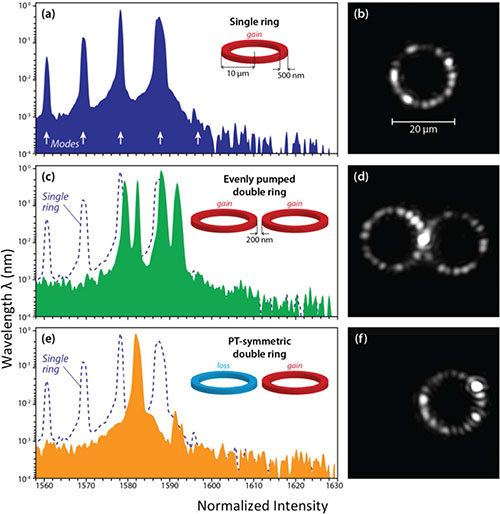Since the invention of the laser, there has been a continuous effort to increase its coherence. High temporal and spatial coherence is what makes lasers indispensable tools in many areas of research and technology ranging from spectroscopy to optical communications. Most lasers, especially those employing semiconductors as the active gain material, tend to support multiple spectral lines or longitudinal modes. Over the years, several schemes have been adopted to effectively suppress undesired excess longitudinal modes. In this regard, distributed feedback (DFB) structures and vertical cavity surface emitting lasers (VCSEL) have been routinely used to select a predetermined frequency line by employing intracavity dispersive elements. However, these techniques are not universally applicable to all types of lasers. Hence the quest for other more-robust methods is still ongoing.

Passive microring resonators are one of the archetypical components of photonic integrated circuits. They support whispering gallery (WG) modes that exhibit high optical quality factors and small footprints, which are also useful attributes of on-chip laser cavities. However, like other micro-scale semiconductor lasers, microrings also support multiple longitudinal modes throughout the gain bandwidth (that can extend up to a few hundred nanometers). Unfortunately, the sparsity of the modes and the sensitivity of such cavities to perturbations prohibit the effective use of intracavity dispersive structures for mode filtering in these configurations.
Prof. Khajavikhan’s group in collaboration with Prof. Christodoulides’ team at CREOL have recently proposed a novel technique based on the notion of parity-time (PT) symmetry in order to suppress unwanted longitudinal modes in heavily multi-modal microring cavities. A new concept borrowed from quantum field theory, PT symmetry is steadily finding new applications in optics. In its unbroken phase, PT symmetry dictates that gain and loss can perfectly compensate one another in an identical pair of amplifying and lossy cavities. As a result, modes of the system propagating in such an arrangement would be completely oblivious to local gain or attenuation. However, this dramatically changes once the contrast between gain and loss exceeds a certain critical level, at which point spontaneous PT symmetry breaking will occur. In the PT symmetry broken regime, the respective modes experience gain or loss in conjugate pairs.

In a 2014 paper entitled “Parity time symmetric microring lasers” published in the November issue of Science magazine, the CREOL researchers use the abrupt nature of the transition at PT breaking threshold to enforce single-mode operation in microring lasers. This effect is harnessed by fabricating closely spaced pairs of microring resonators infused with indiumgallium-arsenide-phosphide quantum wells. PT symmetry is established by withholding the pump from one of the rings and adjusting the inter-ring separation allowed for a precise and seamless tuning of the PT breaking threshold. The schematics in Fig. 1 show how PT symmetric structures filter out the unwanted longitudinal modes in coupled microring resonators. The laser continues to exhibit stable single-mode operation at pump powers that would drive a classical microring cavity deep into the chaotic multimode regime. As an additional benefit, the overall efficiency is substantially increased because – and not in spite of – the presence of losses, the PT laser can extract much more power from the active medium than its conventional counterpart.
The CREOL team suggests that PT-symmetric lasers may serve as building blocks for a new class of integrated photonic devices that could enable optical communications and information processing. Since mode suppression is carried out on the most fundamental level, the design concept can be adapted to manipulate the modal content of a wide range of laser resonators at will. In addition, this class of PT-symmetric microring lasers could be an important step forward in the quest for miniaturization. The ability to dispose of the external filters and stabilization devices may lead to an unprecedented reduction in the footprint of single-mode onchip laser sources, and finally allow for largescale integration of active photonic circuits.
Author
